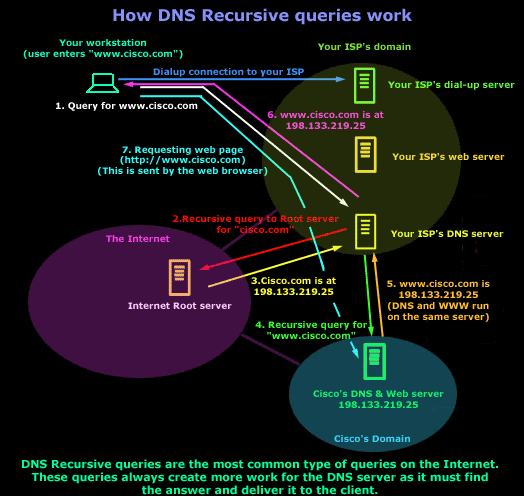

You can access PowerShell in the exact same way as Windows Command Prompt. Boom, you’re in! Accessing Windows PowerShell If you like keyboard shortcuts like I do, you can press Win + R to pull up the Run command. One way is to click on the search icon in your taskbar and type “command prompt” or “cmd.” This should put the app at the top of the search window under “Best match.” There are several ways to start Windows Command Prompt. PowerShell can also access multiple libraries across various systems. Unlike Command Prompt, PowerShell isn’t limited to console programs.
#Dns request example series
This means you can complete a series of cmdlets as opposed to only one command at a time. It features a scripting system, built-in administrative capabilities, and can run batch commands. This shell runs in a blue window and uses Command lets (cmdlets) instead of CMD or MS-Dos commands. PowerShell was first released on Windows in 2006. With this tool, you can run single-line commands. Depending on your machine, the prompt should look like this: C:\> or C:\Users\example. It runs in a simple black window that displays a prompt. This program works “beneath” Windows and gives you more control over your system. Windows introduced its original Command Prompt (CMD) for Microsoft operating systems in 1981. Windows Command Prompt vs Windows PowerShell Note: All examples are from a system running Windows 10. Ready? Of course you are, that’s why you’re here, right? Oh, who am I kidding? You probably skipped this part and went straight to the commands. It also touches on the differences between the two shells. This resource covers useful commands in Windows Command Prompt and PowerShell. Luckily, computers have a built-in utility that can help you do just that. Self.uniq_hosts.From simple to complex configurations, there are times you need to check on how your DNS is behaving. Match_host = next((host for host in self.uniq_hosts if host = name Ntpdh = NTPHandler(options.nic, options.fd)Īssert packet.haslayer(IP), 'Is not IPv4 packet!'Īssert packet.haslayer(UDP), 'Is not UDP packet!'Īssert packet.haslayer(DNS), 'Is not DNS packet!'Īssert packet.dst = self.your_ipv4_address, 'Not your destination IPv4 address!'Īssert packet.sport = 53, 'UDP source port != 53'Īssert packet.ancount != 0, 'DNS answer is empty!'įor answer_index in range(packet.ancount):ĭns_answer = packet.anĪssert self.domain in name, 'Not found target domain in DNS answer!'

Httpsdh = HTTPSHandler(options.nic, options.fd) Httpdh = HTTPHandler(options.nic, options.fd) Tracedh = TraceHandler(options.nic, options.fd)ĭnsdh = DNSHandler(options.nic, options.fd, CCNAME) Pingdh = PINGHandler(options.nic, options.fd) Print('ERROR: Faraday Login incorrect, skip plugin') HTTPRequest(Method="GET", Path="/foo", Host=""), HTTPRequest(Method="GET", Path="/foo", Host="") Self.tshark_process = Popen(tshark_command, shell=True) '" -B 65535 -w ' + RawDnsResolver.tshark_pcap_filename + \ ' and udp src port ' + str(source_port) + \ ' and ip dst ' + destination_ipv4_address + \ ' -f "ether dst ' + destination_mac_address + \ Tshark_command: str = 'tshark -i ' + work_interface + \ Remove(RawDnsResolver.tshark_pcap_filename) :param source_port: Source UDP port in DNS answer (default: 53 - default port for DNS servers) :param destination_ipv6_address: Destination IPv6 address in DNS answer (most likely this is IPv6 address on your network interface) :param destination_ipv4_address: Destination IPv4 address in DNS answer (most likely this is IPv4 address on your network interface)
#Dns request example mac
:param destination_mac_address: Destination MAC address in DNS answer (most likely this is MAC address on your network interface) Print(bcolours.WARNING + ' Stopping.' + bcolours.ENDC) Start_poisen(target, interface, filter_parser()) Print (bcolours.OKBLUE + ' Filter: ' + filter_parser() + bcolours.ENDC) If dns_sniff_gource or dns_sniff or sniff_pkts: Print(bcolours.OKBLUE + '\n Starting Sniffer.\n' + bcolours.ENDC)

Print(bcolours.OKBLUE + '\n Starting DNS Sniffer.\n' + bcolours.ENDC) If target = None or gateway = None and interface = None: If (not dns_sniff_gource) or (dns_sniff or sniff_pkts): #This check is to see if anything but gource parser is set Print(bcolours.OKBLUE + ' For a live gource feed run this command in parallel with this one:' + bcolours.WARNING + '\n\ntail -f ' + random_filename + 'parsed_nmap | tee /dev/stderr | gource -log-format custom -a 1 -file-idle-time 0 -\n\n' + bcolours.ENDC) Unprivileged_user_print(user.CURRENT_USER_NAME)


 0 kommentar(er)
0 kommentar(er)
